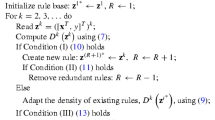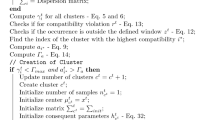Abstract
Evolving participatory learning (ePL) modeling joins the concepts of participatory learning and evolving fuzzy systems. It uses data streams to continuously adapt the structure and functionality of fuzzy models. This paper suggests an enhanced version of the ePL approach, called ePL+, which includes both an utility measure to shrink rule bases, and a variable cluster radius mechanism to improve the cluster structure. These features are useful in adaptive fuzzy rule-based modeling to recursively construct local fuzzy models with variable zone of influence. Moreover, ePL+ extends ePL to multi-input, multi-output fuzzy system modeling. Computational experiments considering financial returns volatility modeling and forecasting are conducted to compare the performance of the ePL+ approach with state of the art fuzzy modeling methods and with GARCH modeling. The experiments use actual data of S&P 500 and Ibovespa stock market indexes. The results suggest that the ePL+ approach is highly capable to model volatility dynamics, in a robust, flexible, parcimonious, and autonomous way.









Similar content being viewed by others
Notes
One must note that ePL considers MISO models whereas ePL+ concerns MIMO models. This difference appears in consequent parameters learning, as will be described in the Subsect. 2.5.
The database was provided by Bloomberg.
References
Akaike H (1974) A new look at the statistical model identification. IEEE Trans Automat Cont 19(6):716–723
Angelov P (2010) Evolving Takagi–Sugeno fuzzy systems from streaming data (eTS+). In: Angelov P, Filev D, Kasabov N (eds) Evolving intelligent systems, Wiley-IEEE-Press, NJ, chap 2, pp 21–50
Angelov P, Filev D (2004) An approach to online identification of evolving Takagi–Sugeno fuzzy models. IEEE Trans Syst Man Cybernetics Part B 34(1):484–498
Angelov P, Filev D (2005) Simpl_eTS: a simplified method for learning evolving Takagi–Sugeno fuzzy models. In: Proceedings 14th IEEE International Conference Fuzzy System, pp 1068–1073
Angelov P, Zhou X (2006) Evolving fuzzy systems from data streams in real-time. In: International Symposium on Evolving Fuzzy Systems, IEEE Press, Ambelside, Lake District, pp 29–35
Angelov P, Zhou X (2008) On-line learning fuzzy rule-based system classifiers from data streams. IEEE Trans Fuzzy Syst 16(6):1462–1475
Attar V, Sinha P, Wankhade K (2010) A fast and light classifier for data streams. Evolv Syst 1(3):199–207
Azzem MF, Hanmandlu M, Ahmad N (2003) Structure identification of generalized adaptive neuro-fuzzy inference systems. IEEE Trans Fuzzy Syst 11(5):668–681
Ballini R, Mendonça ARR, Gomide F (2009a) Evolving fuzzy modeling in risk analysis. Intell Syst Acc Fin Manag 16(1–2):71–86
Ballini R, Mendonça ARR, Gomide F (2009b) Evolving fuzzy modeling of sovereign bonds. J Fin Decis Mak 5(2):3–15
Billings SA, Zhu QM (1994) Nonlinear model validation using correlation tests. Intern J Con 60(6):1107–1120
Chang J, Wei L, Cheng C (2011) A hybrid ANFIS model based on AR and volatility for TAIEX forecasting. Appl Soft Comput 11(1):1388–1395
Chiu SL (1994) Fuzzy model identification based on cluster estimation. J Intell Fuzzy Syst 2(3):267–278
Diebold FX, Mariano RS (1995) Comparing predictive accuracy. J Bus Econom Stat 13(3):253–263
Dovzan D, Logar V and Skrjanc I (2012) Solving the sales prediction with fuzzy evolving models. In: WCCI 2012 IEEE World Congress on Computational Intelligence June, Brisbane, pp 10–15
Dovzan D, Skrjanc I (2011a) Recursive fuzzy c-means clustering for recursive fuzzy identification of time-varying processes. ISA Trans 50(2):159–169
Dovzan D, Skrjanc I (2011b) Recursive clustering based on a Gustafson–Kessel algorithm. Evolv Syst 2(1):15–24
Engle RF (1982) Autoregressive conditional heteroskedasticity with estimates of the variance of UK inflation. Econometrica 50(4):987–1007
Hartert L, Mouchawed MS, Billaudel P (2010) A semi-supervised dynamic version of Fuzzy K-nearest neighbours to monitor evolving systems. Evolv Syst 1(1):3–15
Helin T, Koivisto H (2011) The GARCH-fuzzy density method for density forecasting. Appl Soft Comput 11(6):4212–4225
Hung J (2011a) Adaptive fuzzy-GARCH model applied to forecasting the volatility of stock markets using particle swarm optimization. Inf Sci 181(20):4673–4683
Hung J (2011b) Applying a combined fuzzy systems and GARCH model to adaptively forecast stock market volatility. Appl Soft Comput 11(5):3938–3945
Kasabov N (2002) DENFIS: dynamic evolving neural-fuzzy inference system and its application for time series prediction. IEEE Trans Fuzzy Syst 10(2):144–154
Kasabov NK (1996) Foundations of neural networks, fuzzy systems and knowledge engineering. MIT Press, Cambridge
Kung L, Yu S (2008) Prediction of index futures returns and the analysis of financial spillovers: a comparison between GARCH and the grey theorem. Eur J Operat Res 186(3):1184–1200
Lemos A, Caminhas W, Gomide F (2011) Multivariable gaussian evolving fuzzy modeling system. IEEE Trans Fuzzy Syst 19(1):91–104
Leng G, McGinnity TM, Prasad G (2005) An approach for on-line extraction of fuzzy rules using a self-organizing fuzzy neural network. Fuzzy Sets Syst 150(2):211–243
Lima E (2008) Modelo Takagi–Sugeno evolutivo participativo. Master’s thesis, School of Electrical and Computer Engineering, University of Campinas
Lima E, Hell M, Ballini R, Gomide F (2010) Evolving fuzzy modeling using participatory learning. In: Angelov P, Filev D, Kasabov N (eds) Evolving intelligent systems, Wiley-IEEE-Press, NJ, chap 4, pp 67–86
Lin FJ, Lin CH, Shen PH (2001) Self-constructing fuzzy neural network speed controller for permanent-magnet synchronous motor drive. IEEE Trans Fuzzy Syst 9(5):751–759
Ljung L (1999) System identification. Englewood Cliffs, NJ: Prentice Hall
Lughofer ED (2008) FLEXFIS: a robust incremental learning approach for evolving Takagi–Sugeno fuzzy models. IEEE Trans Fuzzy Syst 16(6):1393–1410
Luna I, Ballini R (2012a) Adaptive fuzzy system to forecast financial time series volatility. J Intell Fuzzy Syst 23(1):27–38
Luna I, Ballini R (2012b) Online estimation of stochastic volatility for asset returns. In: Proceeding of the IEEE Computational Intelligence for Financial Engineering & Economics (CIFEr 2012)
Maciel L, Gomide F, Ballini R (2012a) MIMO evolving functional fuzzy models for interest rate forecasting. In: Proceedings of the IEEE Computational Intelligence for Financial Engineering and Economics (CIFEr 2012)
Maciel L, Gomide F, Ballini R (2012b) An enhanced approach for evolving participatory learning fuzzy modelling. In: Proceedings of the IEEE Congress on Evolving and Adaptive Intelligent Systems (EAIS), Madrid, Spain, pp 23–28
Maciel L, Lemos A, Gomide F, Ballini R (2012c) Evolving fuzzy systems for pricing fixed income options. Evolv Syst 3(1):5–18
McDonald S, Angelov P (2010) Evolving Takagi Sugeno modeling with memory for slow process. Intern J Knowl Based Intell Eng Syst 14(1):11–19
Popov AA, Bykhanov KV (2005) Modeling volatility of time series using fuzzy GARCH models. In: Annals of the 9th Russian–Korean International Symposium on Science and Technology
Qiao J, Wang H (2008) A self-organising fuzzy neural network and its applications to function approximation and forecast modeling. Neurocomputing 71(4–6):564–569
Rong H, Sundararajan N, Huang G, Saratchandran P (2006) Sequential adaptive fuzzy inference system (SAFIS) for nonlinear system identification and prediction. Fuzzy Sets Syst 157(9):1260–1275
Rubio JDJ (2009) SOFMLS: online self-organizing fuzzy modified least-squares network. IEEE Trans Fuzzy Syst 17(6):1296–1309
Schwarz G (1978) Estimating the dimension of model. The Annuals of Statistics 6(2):461–464
Shaker A, Hüllermeier E (2012) IBLStreams: a system for instance-based classification and regression on data streams. Evolv Syst 3(4):235–249
Tung SW, Quek C, Guan C (2011) SaFIN: A self-adaptive fuzzy inference network. IEEE Trans Neural Netw 22(2):1928–1940
Tseng C, Chen S, Wang Y, Peng J (2008) Artificial neural network model of the hybrid EGARCH volatility of the taiwan stock index option prices. Physica A: Stat Mech Appl 387(13):3192–3200
Yager R, Filev D (1994) Approximate clustering via the mountain method. IEEE Trans Syst Man Cybernetics 24(8):1279–1284
Yager R (1990) A model of participatory learning. IEEE Trans Syst Man Cybernetics 20(5):1229–1234
Acknowledgements
The authors thank the Brazilian Ministry of Education (CAPES), the Brazilian National Research Council (CNPq) Grants 304596/2009-4 and 306343/2011-8, and the Research Foundation of the State of São Paulo (FAPESP) Grant 13851-3/2011, for their support.
Author information
Authors and Affiliations
Corresponding author
Rights and permissions
About this article
Cite this article
Maciel, L., Gomide, F. & Ballini, R. Enhanced evolving participatory learning fuzzy modeling: an application for asset returns volatility forecasting. Evolving Systems 5, 75–88 (2014). https://doi.org/10.1007/s12530-013-9099-0
Received:
Accepted:
Published:
Issue Date:
DOI: https://doi.org/10.1007/s12530-013-9099-0




